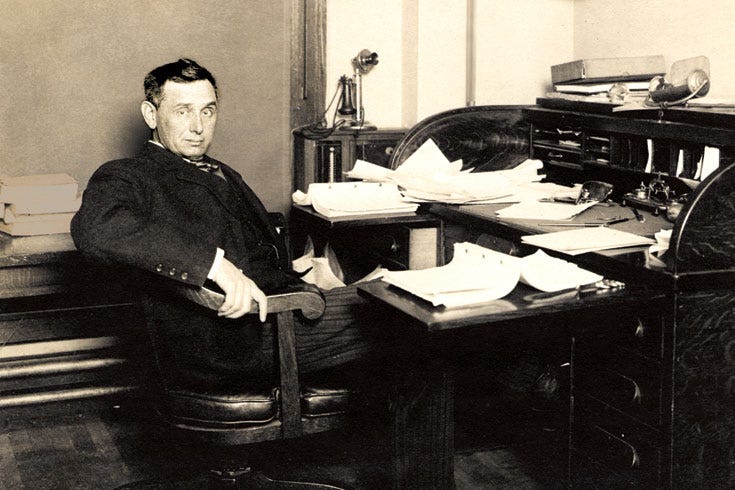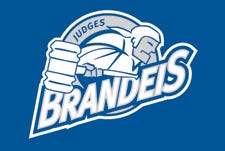D3 Logo Enthusiast: Brandeis Judges, and that gavel
Oh man, did we ever go down a rabbit-hole on this one...
Louis Brandeis died in 1941 and by 1948 Brandeis University had been dedicated in his honor. The exact history of the logo and nickname eludes us, but it appears that the sports teams of Brandeis have been nicknamed ‘The Judges’ either since the school’s founding, or as long as anyone can remember. Let’s return to that in a minute.
Brandeis Swim/Dive
Brandeis Head Coach Nicole Carter has been there since 2018 and, at least by SwimCloud metrics, the team she led last year was Brandeis’ best since, well…long before she got there. The Brandeis Men’s team tracks 18 records, and 13 of them have been set since Ms. Carter took over.1
And four of those records - 200 Free, 500 Free, 1000 Free, and 1650 Free - belong to Senior Sam Dienstag. Mr. Dienstag finished fourth at 2023 Nationals in the mile.
This is a fairly small team. Judging from their online roster we are talking about fewer than thirty athletes on the Men’s and Women’s sides combined. So, they are undersized but mighty.
And of course they compete in the UAA, which is almost certainly the strongest conference in Division III. But, that’s understandable. They are in Boston. It’s not like there are a lot of other colleges around…
The Judges, and the gavel
Anyway, we are here to discuss the nickname and logo.
Unveiled on August 31, 2009, the modern Judges logo really doubles-down on the ‘Judges’ nickname. The primary logo depicts a robed judge with a raised gavel, positioned over the Brandeis name, while the secondary mark centers around a large gavel.
The new branding also addresses a confusion regarding the university's athletics identity. They had a game-day mascot named Ollie the Owl. This led to some misunderstandings with opposing teams who thought they were competing against the ‘Owls’ instead of the ‘Judges.’ The new logos serve to distance Brandeis from the shame and stigma associated with calling your sports teams ‘The Owls.’2
Honestly, we think the graphics are pretty cool. And calling your team ‘The Judges’ is so D3. Division III sports have these unconventional names, that in no way attempt to intimidate or conjure up images of menace. In D3 you get ‘The Judges’, ‘The Diplomats’, ‘The Banana Slugs’, etc. and we think that is great.3
It is going to sound like we are nitpicking.
Louis Brandeis was a lot of things.
He was an innovative litigator, who pioneered (in 1908) a new approach to the presentation of evidence - forever since called the ‘Brandeis Brief.’ Basically he was the first to offer a legal brief to the Supreme Court that rested primarily on non-legal arguments supported by extensive (non-legal) expert testimonies and social science. In this case, the brief concerned the negative effects of unregulated work hours on women and their ability to perform their other important social duties as mothers and pillars of public morality (it was a long time ago, guys), and Brandeis (representing the State of Oregon) argued for the preservation of the law that would protect these vulnerable members of society.4
These sorts of cases connected with Louis Brandeis’ commitment to social activism, especially the protection of the rights of working people, and his almost congenital dislike for large corporations. That political orientation, and prejudices against those of Jewish heritage, made it easy for his opponents to label him a socialist radical, which helps explain why his Supreme Court confirmation process took so long (about five months). But ultimately he was confirmed, became the first Jewish justice named to the U.S. Supreme Court, and served in that capacity for 23 years.
But Louis Brandeis was not a judge, he was a Justice.
About that ‘The Judges’ nickname. Louis Brandeis was an attorney until appointed to the U.S. Supreme Court, at which point he became a ‘justice’. He was never a ‘judge’ and referring to a ‘justice’ by calling him or her a ‘judge’ is not particularly respectful.
Justices and judges are not the same thing.5 At the mid-point of the 20th Century - when Brandeis was founded (1948) - and certainly by 2009, this distinction was well established.
In the hierarchical system of federal courts, the term ‘judge’ confers lower status - they preside over lower courts - and ‘justice’ is the appropriate term for those who sit on the United States Supreme Court.6 So, you could argue that referring to a U.S. Supreme Court Justice as a ‘judge’ is (at best) a little careless, or (at worst) even denigrating.7 It’s not unlike knowing that someone is a physician or has a PhD and still addressing them as ‘Ms.’ or ‘Mr.’ instead of ‘Dr.’8
Obviously, Brandeis University was not trying to insult the memory of Louis Brandeis. But this is a weird choice.
Unless, ‘The Judges’ is not intended as a reference to Louis Brandeis at all. In which case, nevermind.
The gavel
One other thing, judges don’t really use gavels anymore, outside of reruns of My Cousin Vinny.9
But you know who does use gavels? Clerks. Several higher state courts, and the U.S. Supreme Court, announce the opening of a session by having a clerk pound the gavel.
So, Louis Brandeis wasn’t a judge, and judges don’t use gavels. But who cares? It’s a cool looking logo, and we dig the nickname. So, go Judges!
The link for the Women’s records returns a 404 error.
OK, we laid it on a little thick in that last sentence. But seriously, they did - in 2009 - take pains to assert that they were very-much NOT ‘The Owls.’ And we applaud their common sense and decency.
Speaking of ‘The Diplomats’, that is the name nickname of the sports teams at Franklin & Marshall. Benjamin Franklin may have been America’s most famous diplomat, and John Marshall, on his way to becoming a Chief Justice of the Supreme Court, acted as a diplomat to France and then as Secretary of State. So they qualify. Washington & Lee’s nickname - ‘The Generals’ - makes sense as both George Washington and Robert E. Lee were in fact Generals. Washington & Jefferson College’s nickname is ‘The Presidents.’ It is all fairly self-explanatory.
From our modern perspective it is almost hard to believe that the Brandeis Brief was so unprecedented. We are used to this sort of thing now. Go read Brown vs. Board of Ed for example. But apparently back then, only arguments based in legal precedent and formal legal logic were considered appropriate for a legal brief. At least that’s the story. It all feels a little too neat. But let’s go with it. The takeaway is that Brandeis was considered - then and now - an innovative and effective litigator.
Yes, the U.S. Constitution refers to ‘Judges of the supreme Court’ (‘supreme’ is strangely not capitalized) but the U.S. Constitution is a vaguely worded 18th Century document.
Maybe this would be less weird if Louis Brandeis had ever served in a position where his proper title was ‘Judge’. But he did not. That’s hard to imagine from our modern perspective, where a conventional pathway through an Ivy League law school followed by years serving as a lower court judge seems a prerequisite for a Supreme Court nomination.
It is not quite true. Elena Kagan is an obvious counter-example here.
It certainly was not always like this. Of the 110 Justices appointed before the 20th century, 38 did not even have a law degree. Stanley Forman Reed was the last Supreme Court Justice without a law degree and his time on the court ended in 1957.
It is also funny who gets this wrong. If you google ‘Supreme Court judge’ the hits are to foreign news sources - Al Jazeera, BBC, etc.
Want a few articles on how judges don’t really use gavels anymore?








